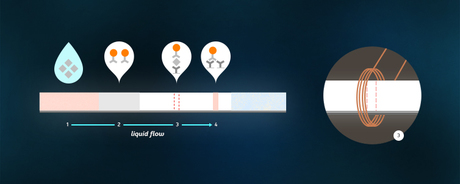A biosensor test strip based on magnetic nanoparticles

Researchers from the General Physics Institute of the Russian Academy of Sciences (GPI RAS) and Moscow Institute of Physics and Technology (MIPT) have developed a biosensor test system based on magnetic nanoparticles.
Writing in the journal Biosensors and Bioelectronics, they say their system is designed to accurately measure the concentration of protein molecules (eg, biomarkers which indicate the onset or development of a disease) in various samples, including opaque solutions or strongly coloured liquids.
Conducted using small test strips made of porous material, the system enables tests to be quickly conducted, in field conditions, by persons other than specially trained staff. A droplet of the sample liquid is applied to one end of the strip and, after a short period, the result is shown as the activation of one or two test lines. The test strips can be stored for a long time before use.
“Normally, tests that can be performed not only under lab conditions but also in the field use fluorescent or coloured markers, and the results are determined visually, by sight or by using a video camera,” explained corresponding author Alexey Orlov, a research fellow at GPI RAS.
“In our case, we are using magnetic particles, which have a significant advantage: they can be used to conduct analyses even if the test strip is dipped into a completely opaque liquid, to determine the substances in whole blood for example. The precise numerical measurement is conducted entirely electronically using a portable device. This completely excludes any ambiguity.”
At a molecular level, the magnetic nanoparticles ‘link’ with antibodies to the required protein. They are then placed on a porous plate close to the intended point of contact with the test solution. The liquid, which spreads along the plate due to capillary action, captures the magnetic particles. It then meets two lines — the test line and the control line.
The test line contains antibodies that capture the protein in question and also magnetic markers that became attached to molecules of the protein. The control line only captures the antibodies with magnetic markers and serves as an indicator as to whether the test is suitable for use.
After the sample has permeated the test strip and the antibodies have interacted with one another, the result can be read. Scientists are not only able to use the test to detect a protein, but they can also determine the concentration of this protein — to a level of accuracy which exceeds that of methods performed in laboratory conditions.
The test system allows measurements to be taken over a wide dynamic range — that is, in a very dilute solution as well as in a very saturated solution. The upper limit of the test concentration is more than 4000 times greater than the lower limit.
Furthermore, the system can be used in a wide number of applications apart from diagnostics. The biosensor is able to conduct analyses on food products and medicines, as well as to carry out environmental monitoring. With no complicated or expensive equipment necessary to accompany the device, its developers anticipate that the system will make a rapid transition from a laboratory prototype to mass production.
Blood test for chronic fatigue syndrome developed
The test addresses the need for a quick and reliable diagnostic for a complex,...
Droplet microfluidics for single-cell analysis
Discover how droplet microfluidics is revolutionising single-cell analysis and selection in...
PCR alternative offers diagnostic testing in a handheld device
Researchers have developed a diagnostic platform that uses similar techniques to PCR, but within...







